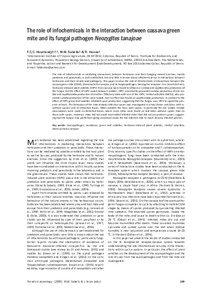| dc.contributor.author | Hountondji, F.C.C. |
| dc.contributor.author | Sabelis, M. |
| dc.contributor.author | Hanna, R. |
| dc.date.accessioned | 2019-12-04T11:15:10Z |
| dc.date.available | 2019-12-04T11:15:10Z |
| dc.date.issued | 2009 |
| dc.identifier.citation | Hountondji, F., Sabelis, M. & Hanna, R. (2009). Role of infochemicals in the interaction between cassava green mites and its fungal pathogen Neozygites tanajoae. In: Trends in Acarology: proceedings of the 12th International Congress of Acarology, (p. 249-253): Springer. |
| dc.identifier.isbn | 978-90-481-9836-8 |
| dc.identifier.uri | https://hdl.handle.net/20.500.12478/2928 |
| dc.description.abstract | The role of infochemicals in mediating interactions between herbivores and their foraging natural enemies, mainly predators and parasitoids, is well established, but very little is known about infochemical use in interactions between herbivores and their sit-and-wait pathogens. This paper reviews the role of infochemicals in interactions between the cassava green mite (CGM), Mononychellus tanajoa,and its fungal pathogen, Neozygites tanajoae. In a closed-dish test, herbivore-induced plant volatiles (HIPV) from cassava were found to influence conidia and capilliconida production of the fungus but the effect of HIPV varied between isolates. HIPV consistently promoted conidia production of one iso- late and capilliconidia production of another. Olfactory trials with one of the HIPV, methyl salicylate (MeSA), also pro- moted conidia production of the same isolate, but no effect was found on capilliconidia production. In contrast to the effect of HIPV, green leaf volatiles inhibited spore production, suggesting that the fungus uses HIPV to signal the pres- ence of hosts. The behaviour of the mite towards infective spores was investigated in a two-choice unit (discs with vs. without spores) and on detached leaves. Mites avoided the discs with spores, in particular for one isolate. Similar observations were made on detached leaves where more mites were found on leaf lobes without spores than on those with spores. However, mites did not avoid mummified infected mites that did not yet produce spores, suggest- ing that the fungus may profit from going unnoticed inside the live infected mite to reach densely infested patches. |
| dc.description.sponsorship | Danish International Development Agency |
| dc.description.sponsorship | International Fund for Agricultural Development |
| dc.language.iso | en |
| dc.subject | Acaropathogen |
| dc.subject | Avoidance |
| dc.subject | Green Leaf Volatiles |
| dc.subject | Herbivore-Induced Plant Volatiles |
| dc.subject | Methyl Salycilate |
| dc.subject | Mononychellus Tanajoa |
| dc.title | Role of infochemicals in the interaction between cassava green mites and its fungal pathogen Neozygites tanajoae |
| dc.type | Conference Paper |
| dc.description.version | Peer Review |
| cg.contributor.affiliation | International Institute of Tropical Agriculture |
| cg.contributor.affiliation | University of Amsterdam |
| cg.contributor.affiliation | Expertise, Action and Research for Development, Benin |
| cg.coverage.region | Africa |
| cg.coverage.region | Acp |
| cg.coverage.region | West Africa |
| cg.coverage.region | South America |
| cg.coverage.country | Brazil |
| cg.coverage.country | Benin |
| cg.authorship.types | CGIAR and developing country institute |
| cg.iitasubject | Cassava |
| cg.iitasubject | Pests Of Plants |
| cg.iitasubject | Plant Diseases |
| cg.iitasubject | Disease Control |
| cg.accessibilitystatus | Limited Access |
| local.dspaceid | 94029 |

